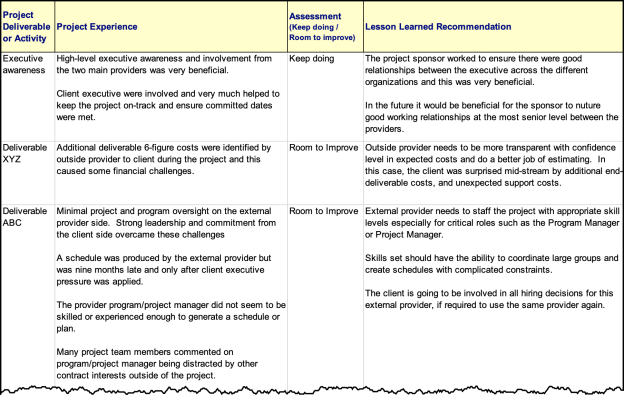4 Important Data Pieces for Lessons Learned
The purpose of this blog post is to cover how to do lessons learned with a spreadsheet layout example to use for collecting and distributing the results and recommendations of the analysis.
Lessons Learned are under Step 5, TRANSITION and CLOSE, in the Project Management MPM model.

Lessons Learned are under Step 5, TRANSITION and CLOSE, in the Project Management MPM model
Lessons Learned identifies improvements and best practices
The purpose of Lessons learned is to review significant activities or processes that took place during the project and ask if things were done in the best way possible or if they need to be changed for next time.
You don’t have time to analyze all deliverables or activities, and there is limited value in looking at small things that didn’t have a big impact, but significant sets of activities or events that took up a lot of time, or were pivotal for the project are worth reviewing, especially to learn for next time.

Lessons Learned helps to reinforce and remember to repeat the things that worked when doing the next project
So, the goal then is to change or update inefficient ways of executing and improve them for the next project, or if something was done well then identify that as well and do it the same way next time.
In the table below are some examples of lessons learned and the four important pieces of data to capture during the analysis.

Document lessons learned for future reference
Four important data pieces for lessons learned
The four important columns of data as per the table above, are as follows:
- Project Deliverable or Activity: Something that clearly and uniquely defines the deliverable or activity.
- Project Experience: What did the project experience, good or bad, about the deliverable or activity.
- Assessment: Keep Doing / Room to Improve. Should the way it was done continue for next time or how can it be improved for next time?
- Lessons Learned Recommendation: If something needs to change or improve, what is the lessons learned recommendation.
Even though for the project team, this may feel like an opportunity to get some issues off their chest and broadcast some of the challenges they had to struggle with because of decisions at a higher level or an external entity, it is best to avoid that and take the high road.
Keep the lessons learned objective and general
Describe the Lessons Learned Recommendation as if it was being provided to someone objective who was not on the project team or involved closely with the project. The descriptions should be general enough about processes or relationships that they can be used by another project completely unrelated to yours.
After they are complete, the Lessons Learned Recommendations are provided to a central group which manages all of the projects such as a Project Management Office. If this entity doesn’t exist then keep it with the project’s operational support folders because future projects looking for recommendations will most likely start looking in that location first.
Summary
Lessons learned is a valuable way to make improvements to how to execute or create outcomes for future projects.
By reviewing significant activities or processes that took place during the project and ask if things were done in the best way possible or if they need to be changed for next time, the project can provide good quality recommendations for how things can be done better next time.
It is important to describe the Lessons Learned Recommendations in general enough terms that they can be used by another project completely unrelated to yours.
Action Steps / Apply This Knowledge
- Create the lessons learned table above for your current project.
- Even if the project is not complete, add at least three lessons learned that you are aware of right now. Use some minor ones if that helps fill out the three. It is just good to get into the frame of mind of what they look like in the table to get used to how they work.
- If there are some lessons learned recommendations that can be applied right now to improve later aspects of the project, then implement those now rather than waiting until the project is complete.
- Prompt engineering guidance for AI GPTs such as chatGPT: “I’m a business leader managing a project that will be winding down to a close soon. For the Lessons Learned, what are some details I need to capture to incorporate for the next project about what worked that we should repeat, or what didn’t work that needs to be done differently?”
Learn More to Do More
Business evolves through change initiatives otherwise known as projects. The key to managing these change initiatives so you have more time, and less stress is to use simple strategies and tools.
Check out the Learning Hub’s other Articles with Actionable Steps, organized with a busy leader in mind, by topic or main idea, and with some AI GPT (e.g. ChatGPT) prompt engineering suggestions under the Action steps: https://simplepmstrategies.com/learning-hub-index
TRANSITION – Lessons Learned
© Simple PM Strategies 2024
